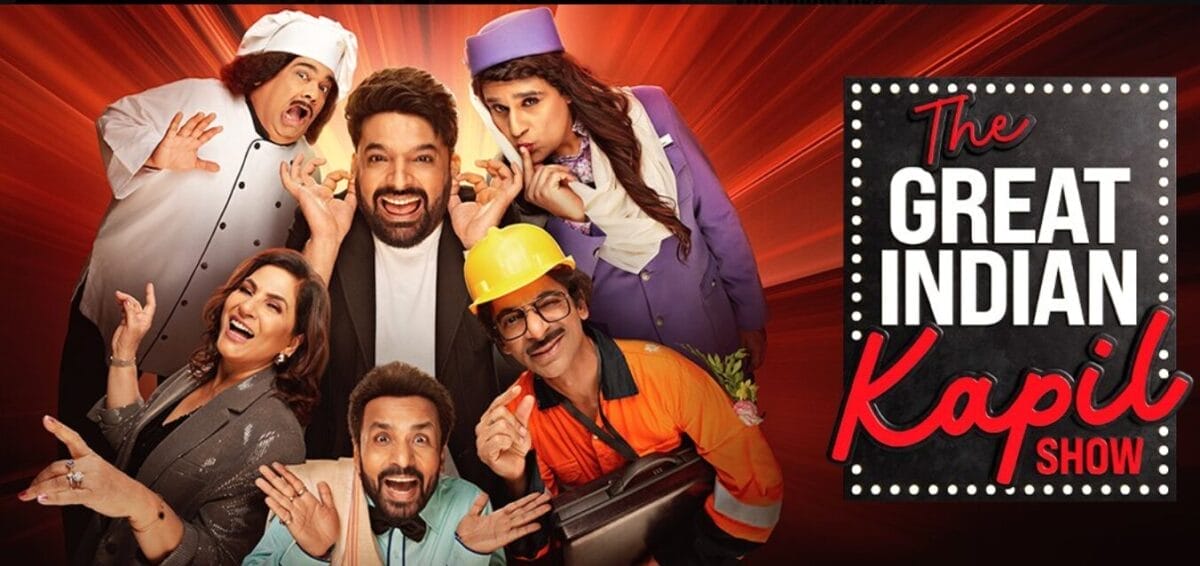Humour is subjective. However, what many fail to understand is that – humour should be about punching up and not down. The Kapil Sharma Show, now The Great Indian Kapil Show on Netflix is a classic example of punching down for humour purposes. The host, Kapil Sharma is a standup comedian who is popular for his witty quips, skits and jokes.
The Kapil Sharma Show, now The Great Indian Kapil Show on Netflix is a classic example of punching down for humour purposes.
But oftentimes the jokes he makes are at the expense of women. The supposed comedy is downright sexist. Unfortunately, people eagerly wait to tune in to his show every weekend. It tells what sells in the subcontinent and the rest of the world. The laughter and claps at the misogynistic, derogatory and regressive humour reflect the mindset of the majority.
The show, a successful runner for several years, has a massive following. The set design and characters of the show have changed over the years. What’s yet to upgrade is the humour. The regressive tonality of the comedic content persists. The punching down gets applause for it caters to the status-quo – upper-class heteronormative patriarchy.
The Kapil Sharma Show and the Madonna-whore complex
The comedy show relies on stereotypes and exaggerated characters to perpetuate gender biases and maintain the Madonna Whore Complex (MWC).
The comedy show relies on stereotypes and exaggerated characters to perpetuate gender biases and maintain the Madonna Whore Complex (MWC).
‘The Madonna Whore Complex (MWC) is a psychological complex often perpetuated by heterosexual, cisgender males which places women into two categories the “Madonna” a woman who is pure, virtuous, and nurturing, or a “Whore,” a woman who is deemed as overly sexual, manipulating, and promiscuous.’ writes Brooke Brownlee for Modern Intimacy.
Some of the female characters in the show, played by male actors, are overly sexualised and objectified, suggesting the “whore” ideals. The host on the show often establishes that women are goddesses, derived from the context of the Hindu religion, reinforcing the “Madonna” archetype. The show distinctly separates women into two groups: the virginal, pure Madonna, and the sexual whore. The platform continues endorsing dangerous notions that women can only fit into either of these two extreme categories. As an influential media, the show furthers rigid notions of limiting women’s agency and freedom by determining their sexuality with one or the only other category.
Limiting queerness to promiscuity In The Kapil Sharma Show
In addition, there are male characters who crossdress and play the roles of women with overt libido who sexualise male guests. This depiction harmfully adds to the preexisting stereotypes of promiscuity that queer folks are tagged with. And, importantly, it must be noted that cross-dressing traditions are not a yardstick of trans friendliness. What is also interesting is that Kapil Sharma always plays smart and rational characters that chastise female or cross-dressing characters when he is not flirting with celebrity heroines.
There are also religious notions attached to viewing queerness. People who follow Hinduism cite gender ambiguity in gods or the queer gods for their acceptance of queer folks. Likewise, there is a phenomenon of viewing the hijra community as gods and seeking their blessings. However, that does not extend to genuine allyship or humanising of queer individuals.
Society, an enabler of problematic content
The show, a prime case of problematic mainstream entertainment, is not an anomaly in perpetuating sexist, classist and queerphobic humor. Various forms of pop culture rooted in gender and class stereotypes do prevail with success. The blockbuster film Animal from last year is a solid example of the public validating its portrayal of sexism and toxic masculinity. The depiction of sexism and classism in contemporary media enables stereotypes and leads to a rise in discrimination already rampant in societies. The veil of seemingly harmless fun, treated as non-serious, non-threatening, playful and innocent laughter, harms gender equality.
The show’s audience is receptive to the humor that promotes gender and class prejudice. Their shared laughter and applause to encourage tolerance for discrimination. Moreover, people start to incorporate such humour in conversations or life and soon enough infuse it in behaviors. The notion of comedy in mainstream media normalises the damaging acceptance of sexism. Throughout the years, with its jokes, skits, audience and reception, The Kapil Sharma Show has influenced people to grow tolerant to gender discrimination.
Kapil is a representation of the society he grew up/lives in, as a cisgendered heterosexual male whose identity is never used for comic relief.
Kapil is a representation of the society he grew up/lives in, as a cisgendered heterosexual male whose identity is never used for comic relief. And even if he is made fun of, his privileges always outweigh his struggles. The heteronormative patriarchy – a system built for men like him, favours his jokes made at the expense of others.
The comedy in the show reflects the dominant attitude society holds and maintains. Media mirrors the established biases toward those considered “inferior” and exploits them as punching bags for humor. While gender sensitivity often becomes the talk of the town, the deep-rooted misogyny devoids it from dominant discourses. The gross presentation of extremely prejudiced gender roles and traits in the show with its huge fan base helps fuel the fire of gender violence in an already struggling world. When the audience is laughing at a sexist joke, they are not laughing with the women but rather laughing at them.
A not so funny reality check
The display of society and culture in the show, unfortunately, does paint a realistic picture. Be it sexist remarks, fatphobic jokes or classist quips, the show truly mirrors the insensitivity towards “others”. Kapil manages to praise a celebrity for her accomplishments and insult a female character in the same sentence. The cognitive dissonance that strongly grips the show’s format is baffling. However, the politics behind such jokes are not confusing if one is observant.
Questioning what we find funny might be a good start. It can be surprising to realise what and how many preconceived notions we hold onto because of the way we were brought up, the society we live in and the media we consume. Entertainment should not exist at the expense of the oppressed. Comedians should unlearn the cheap attempts at humour and try taking digs at those with power and privilege.
The jokes we grew up hearing most likely are rooted in some form of bias if we truly start paying attention. The world has moved past the point of unfunny sexist, colourist and queerphobic jokes, as should the Kapil Sharma Show.
Not everything is funny in the name of comedy. Someone with a good sense of humour would know that.








